| Podao | |
|---|---|
 A photograph of a Chinese podao, with the handle wrapped in hemp rope. |
Types of Chinese weaponry | |
|---|---|
| Swords | |
| Polearms |
|
| Roped/chained | |
| Projectile |
|
| Handheld |
|
| Protection |
|
| Major lists | |
| Podao | |
|---|---|
 A photograph of a Chinese podao, with the handle wrapped in hemp rope. |
Types of Chinese weaponry | |
|---|---|
| Swords | |
| Polearms |
|
| Roped/chained | |
| Projectile |
|
| Handheld |
|
| Protection |
|
| Major lists | |

A polearm or pole weapon is a close combat weapon in which the main fighting part of the weapon is fitted to the end of a long shaft, typically of wood, extending the user's effective range and striking power. Polearms are predominantly melee weapons, with a subclass of spear-like designs fit for thrusting and/or throwing. Because many polearms were adapted from agricultural implements or other fairly abundant tools, and contained relatively little metal, they were cheap to make and readily available. When belligerents in warfare had a poorer class who could not pay for dedicated military weapons, they would often appropriate tools as cheap weapons. The cost of training was comparatively low, since these conscripted farmers had spent most of their lives using these "weapons" in the fields. This made polearms the favoured weapon of peasant levies and peasant rebellions the world over.
This is a list of types of swords.
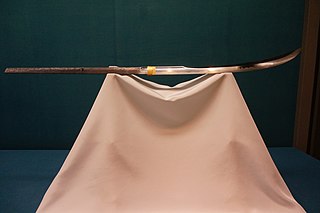
The naginata is a polearm and one of several varieties of traditionally made Japanese blades (nihontō). Naginata were originally used by the samurai class of feudal Japan, as well as by ashigaru and sōhei. The naginata is the iconic weapon of the onna-musha, a type of female warrior belonging to the Japanese nobility. A common misconception is that the Naginata is a type of sword, rather than a polearm.

The jian is a double-edged straight sword used during the last 2,500 years in China. The first Chinese sources that mention the jian date to the 7th century BCE, during the Spring and Autumn period; one of the earliest specimens being the Sword of Goujian. Historical one-handed versions have blades varying from 45 to 80 centimeters in length. The weight of an average sword of 70-centimetre (28-inch) blade-length would be in a range of approximately 700 to 900 grams. There are also larger two-handed versions used for training by many styles of Chinese martial arts.

Dao are single-edged Chinese swords, primarily used for slashing and chopping. They can be straight or curved. The most common form is also known as the Chinese sabre, although those with wider blades are sometimes referred to as Chinese broadswords. In China, the dao is considered one of the four traditional weapons, along with the gun, qiang (spear), and the jian, called in this group "The General of Weapons".
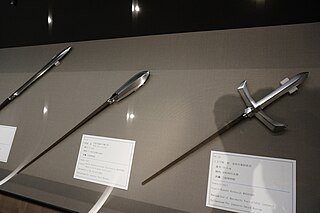
Yari (槍) is the term for a traditionally-made Japanese blade in the form of a spear, or more specifically, the straight-headed spear. The martial art of wielding the yari is called sōjutsu.

The ōdachi (大太刀) or nodachi is a type of traditionally made Japanese sword used by the samurai class of feudal Japan. The Chinese equivalent of this type of sword in terms of weight and length is the miaodao or the earlier zhanmadao, and the Western battlefield equivalent is the Zweihänder.

The nagamaki is a type of traditionally made Japanese sword (nihontō) with an extra long handle, used by the samurai class of feudal Japan.

The zhanmadao was a single-bladed anti-cavalry Chinese sword. It originated during the Han dynasty and was especially common in Song China (960–1279).

Sōhei were Buddhist warrior monks of both classical and feudal Japan. At certain points in history, they held considerable power, obliging the imperial and military governments to collaborate.

Changquan refers to a family of external martial arts styles from northern China.
The traditions of Korean bladesmithing and swordsmanship have served a central place in the military history of Korea for thousands of years. Although typical Korean land battles have taken place in wide valleys and narrow mountain passes, which favor use of spears and bows, the sword found use as a secondary, close-quarters weapon, in addition to far more prominent role during sieges and ship-to-ship boarding actions. Higher quality, ceremonial swords were typically reserved for the officer corps as a symbol of authority with which to command the troops. Ceremonial swords are still granted to military officials by the civilian authority to this day.
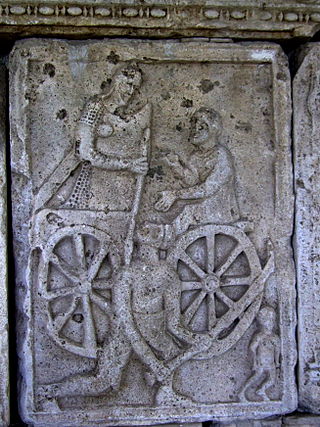
The rhomphaia was a close-combat bladed weapon used by the Thracians as early as 350-400 BC. Rhomphaias were weapons with a straight or slightly curved single-edged blade. Although the rhomphaia was similar to the falx, most archaeological evidence suggests that rhomphaias were forged with straight or slightly curved blades, presumably to enable their use as both a thrusting and slashing weapon. The blade was constructed of iron and used a triangular cross section to accommodate the single cutting edge with a tang of rectangular cross section. Length varied, but a typical rhomphaia would have a blade of approximately 60–80 cm (24–31 in) and a tang of approximately 50 cm (20 in). From the length of the tang, it can be presumed that, when attached to the hilt, this portion of the weapon would be of similar length to the blade.
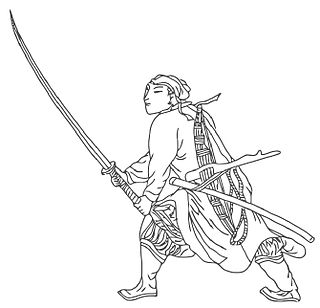
The changdao was a two-handed, single-edged Chinese sword. The term changdao has been translated as "long saber," "saber-staff," or "long-handled saber." During the Ming dynasty, changdao was often used as a general term for two-handed swords and was used in the frequent raids along the coast. After Republican Era, the term miaodao is sometimes used to describe changdao due to similarity. Tang dynasty sources describe the changdao as being identical to the modao, but the modao may have been a double-edged weapon like earlier zhanmajian.
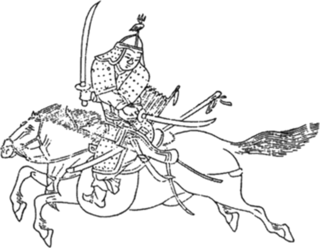
Commissioned in 1790 by King Jeongjo, the Muyedobotongji expanded on the eighteen weapons systems identified in the Muyeshinbo of 1758.

A javelin is a light spear designed primarily to be thrown, historically as a ranged weapon. Today, the javelin is predominantly used for sporting purposes such as the javelin throw. The javelin is nearly always thrown by hand, unlike the sling, bow, and crossbow, which launch projectiles with the aid of a hand-held mechanism. However, devices do exist to assist the javelin thrower in achieving greater distances, such as spear-throwers or the amentum.
Historically, Chinese swords are classified into two types, the jian and the dao. A Jian is a straight, double-edged sword mainly used for stabbing, and has been commonly translated into the English language as a longsword; while a dao is a single-edged sword mainly used for cutting, and has been translated as a saber or a "knife".
The Muyesinbo is a Korean martial arts manual published in 1759. The book is a revision of the older Muyejebo, made during the reign of King Youngjo (1724–1776). It adds twelve disciplines or "skills" of both armed and unarmed fighting by Prince Sado to the original six which were descbribed in the Muyejebo. No copies of the Muyesinbo have survived, but its contents can easily be determined by tracing back and comparing the Muyejebo with the later Muyedobotongji.
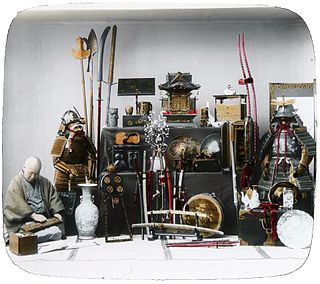
Major innovations in the history of weapons have included the adoption of different materials – from stone and wood to different metals, and modern synthetic materials such as plastics – and the developments of different weapon styles either to fit the terrain or to support or counteract different battlefield tactics and defensive equipment.
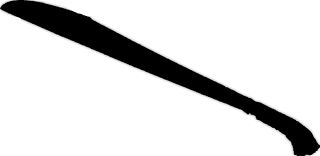
The bangkung or bangkon is a slashing weapon, meant to deliver hacking-type blows. It is a short sword originating in the Sulu Archipelago of the Philippines. The bangkung was used primarily by the Moro people of the Sulu and is not associated with Moros in other areas such as Mindanao, although it is sometimes found in coastal regions. While the bangkung is a very effective sword, it was not popular unlike the panabas and the pirah and for this reason it is one of the most rarely found Moro edged weapons. Few were produced and even fewer survive.